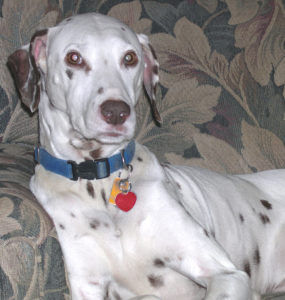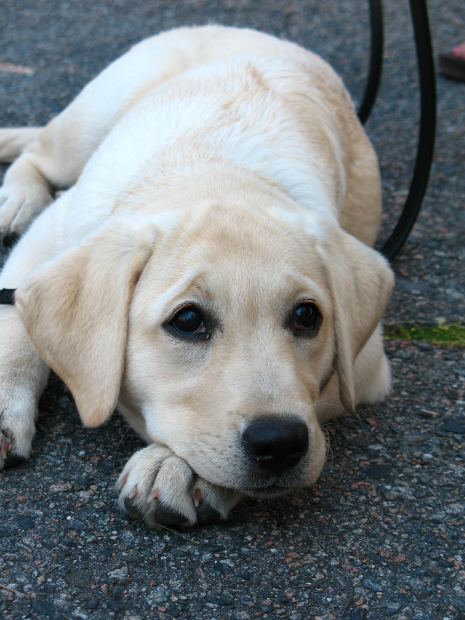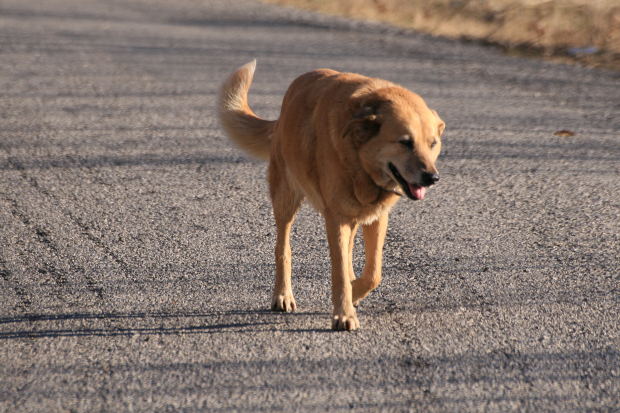Even though your dog, Snickers, has only been missing for three days, you are worrie d you’ll never see her again. You promise yourself you’ll never get another dog because, obviously, you can’t be trusted. You are wondering why, WHY DID YOU ASK THE NEIGHBOR’S TEENAGER TO WALK SNICKERS WHILE YOU WERE ON VACATION? And why, why did the kid decide to go jogging with Snickers without putting her leash on? You are worried about the kid’s generation being able to lead the country while you are in your retirement years when you suddenly see a familiar shape three yards over from yours. You recognize her instantly – it’s Snickers!
d you’ll never see her again. You promise yourself you’ll never get another dog because, obviously, you can’t be trusted. You are wondering why, WHY DID YOU ASK THE NEIGHBOR’S TEENAGER TO WALK SNICKERS WHILE YOU WERE ON VACATION? And why, why did the kid decide to go jogging with Snickers without putting her leash on? You are worried about the kid’s generation being able to lead the country while you are in your retirement years when you suddenly see a familiar shape three yards over from yours. You recognize her instantly – it’s Snickers!
You are tempted to run out of the door and call her to you, but you resist that temptation when you see her run from the neighbor’s children…children Snickers has always loved playing with. What if she runs from you, too? Could she have forgotten the family, the community that loves her after only three days? Now what?
Well, if your dog is lost and you see her, you are 100% right to pause, collect yourself, and, above all, calm yourself down. You’ll be excited to see your dog, of course, but your dog may be equally anxious to protect herself from what she perceives to be threats, including you. And, she may run as far away from you as possible.
If she does, make sure you are prepared for the next time you see your pet. Load your car with non-perishable goodies and toys she normally enjoys so you can use them to lure your dog to you the next time you see her. Make sure you have enough goodies…it may take quite a few treats to convince your dog to come to you. Make sure you always have a leash at your disposal and a spare collar as well in case your dog has lost hers during her travels.
When you arrive at the scene of where your dog was most recently seen, remain calm…and quiet. Don’t honk your car’s horn, slam its doors, or start yelling your dog’s name. Simply arrive and let your dog get used to you being in the vicinity of her. Talk to her quietly, using words and phrases that remind her of the comfort and happiness you’ve given her throughout her life. Say things like, “Wanna go for a walk?” Or, “It’s dinnertime!”
Remember to be patient as you literally inch closer and closer to your dog and pay close attention to the clues your pet is giving you about your approach. If your dog braces as if she’s preparing to run away, stop moving and lower yourself to the ground. When your dog is calm again, try to get a bit closer to her by walking slowly in a sideways direction with your arms at your sides. Use your lips to smile, not your teeth, so your dog doesn’t think you are growling at her. Also, don’t look directly at your dog or stare at her as a predator would.
As you are getting close enough to your dog to use the treats you brought to lure her to you, assume a submissive position by getting as close to the ground as possible as you continue your advance – consider crawling, if necessary. By doing this and using positive tones when you speak to your pet, you will demonstrate that you are not a threat to her well-being. When you’re within throwing distance, your pet will be able to see and smell the food you’ve brought for her.
Gently and slowly toss some treats off to the side of your dog without hitting her. Hold your eyes closed and move your head down and off to the side to show your dog that you are not going to challenge her for the food. Do this repeatedly until your dog is comfortable with your proximity to her.
When your dog has finished the first round of treats, throw a few more, but make sure they land farther from her and closer to you. Give your dog praise with every step she takes closer to you, even if it’s only to get some food. Pretend you are eating some of the treats you still have at the ready, too. Lick your lips and tell your dog how good the treats are…and ask her if she wants some more.
When your dog is finally close enough to you for you to grab, you will have to make a choice about how to secure your pet. You can offer more treats in one hand while attaching a leash to your dog’s collar with your other one. Or, you can grab your pet’s collar, quickly taking in any slack. Or, you can rub your dog’s muzzle while attaching her leash to her collar.
If your dog’s collar is no longer around her neck, put the end of her leash through the wrist loop at the top, and loop the end of the leach around your wrist several times while holding it securely in your hand. The leash will act as a slip lead and tighten once it’s around your dog’s neck.
If you’re dog hasn’t been seen, but you know where your dog is likely to be while she is lost, find a spot in the vicinity where you can wait with some treats and her favorite toys. When you hear your dog coming, put out some treats that will lead her to you.
If you have people who are helping you find your dog, make sure they don’t distract her while you are trying to lure her to you. Your dog should be focused on you and you alone. Instruct your helpers to assume discreet positions that will enable them to see where your dog was going in case she runs away from you. Make sure you give your friends and family members enough treats for them to try to lure your pet to them in case she gets close enough to their positions.
If a dog is new to your family, whether you’ve just taken in a foster or adopted an unfamiliar dog, help your new pet to start trusting you and to learn your unique scent by putting food and water out in the same location every single day she is lost. Talk to the dog, address her by name even if it’s a new one. Try to bond with your dog even if you can’t see her. If you are consistent with your efforts, it’s likely your dog will eventually get close enough to you for you to bring her back to the home she may only be seeing for the first time!
Our tips, ideas and articles are based on information gathered from over 3000 successful lost dog recoveries. Any advice or suggestions made by Lost Dogs of Wisconsin/Lost Dogs Illinois is not paid-for professional advice and should be taken at owner’s discretion.









